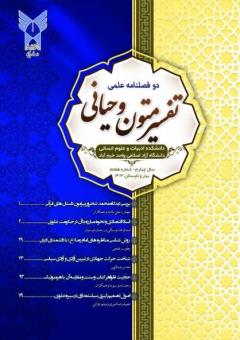اسکاتولوژی تطبیقی: مفاهیم آخرت و قیامت در قرآن، تورات و انجیل
محورهای موضوعی : نقد کلامی و فلسفی موضوعات دینی- اسلامی
1 - استادیار فلسفه اسلامی، مرکز یزد، دانشگاه پیام نور، یزد، ایران
کلید واژه: آخرت شناسی, قیامت, رستاخیز, عدالت الهی, نجات, ملکوت خدا,
چکیده مقاله :
این پژوهش به بررسی مقایسهای مفاهیم اسکاتولوژیک در قرآن کریم، تورات و انجیل پرداخته و تصاویر مختلف آخرت، قیامت، و سرنوشت نهایی انسان را در این سه متن مقدس تحلیل میکند. اسکاتولوژی به عنوان علم آخرتشناسی، در شکلگیری امید و ترس مذهبی، انگیزههای اخلاقی، و نگرش به زندگی دنیوی نقش بنیادین دارد. در قرآن، تصویر دقیقی از روز قیامت، میزان، حساب، بهشت و جهنم ارائه میشود؛ تورات بر احیا و بازگشت به سرزمین موعود تمرکز دارد؛ و انجیل بر زندگی جاودان، رستاخیز مسیح، و ملکوت خدا تأکید میکند. با استفاده از روش تحلیل مضمونی، این مطالعه نشان میدهد که مفاهیم مشترکی چون عدالت الهی، پاسخگویی اعمال، امید به نجات، و تحقق نهایی مشیت خداوند در هر سه سنت یافت میشود. این یافتهها اهمیت درک اسکاتولوژی مشترک را در تقویت گفتگوی بینادیانی و کاهش تنشهای مذهبی برجسته میسازد
This research examines the comparative eschatological concepts in the Holy Qur'an, Torah, and Gospel, analyzing different images of afterlife, resurrection, and humanity's ultimate destiny in these three sacred texts. Eschatology, as the science of end-times, plays a fundamental role in shaping religious hope and fear, moral motivations, and attitudes toward worldly life. The Qur'an presents a detailed picture of the Day of Judgment, the Scale, reckoning, Paradise and Hell; the Torah focuses on revival and return to the Promised Land; and the Gospel emphasizes eternal life, Christ's resurrection, and the Kingdom of God. Using thematic analysis method, this study shows that common concepts such as divine justice, accountability for deeds, hope for salvation, and ultimate fulfillment of God's will are found in all three traditions. These findings highlight the importance of understanding shared eschatology in strengthening interfaith dialogue and reducing religious tensions.
منابع فارسی:
آشتیانی، س. ج. (۱۳۹۹). معاد در ادیان ابراهیمی. قم: بوستان کتاب.
راستگو، س. م. (۱۳۹۸). قیامتشناسی تطبیقی. تهران: پژوهشگاه فرهنگ و اندیشه اسلامی.
سجادی، س. ج. (۱۳۹۷). مرگ و رستاخیز در قرآن و انجیل. قم: دار الحدیث.
قرائتی، م. (۱۳۹۶). تفسیر نور: معاد و قیامت. تهران: مرکز فرهنگی درسهایی از قرآن.
محمدی اشتهاردی، م. (۱۳۹۵). اسکاتولوژی در اسلام و مسیحیت. قم: پژوهشکده حوزه و دانشگاه.
English References:
Collins, J. J. (2019). The apocalyptic imagination: An introduction to Jewish apocalyptic literature (3rd ed.). Eerdmans Publishing.
Hick, J. (2020). Death and eternal life. Westminster John Knox Press.
McDannell, C., & Lang, B. (2018). Heaven: A history (2nd ed.). Yale University Press.
Smith, J. I., & Haddad, Y. Y. (2017). The Islamic understanding of death and resurrection. Oxford University Press.
Wright, N. T. (2021). The resurrection of the Son of God (Reprint ed.). Fortress Press.


